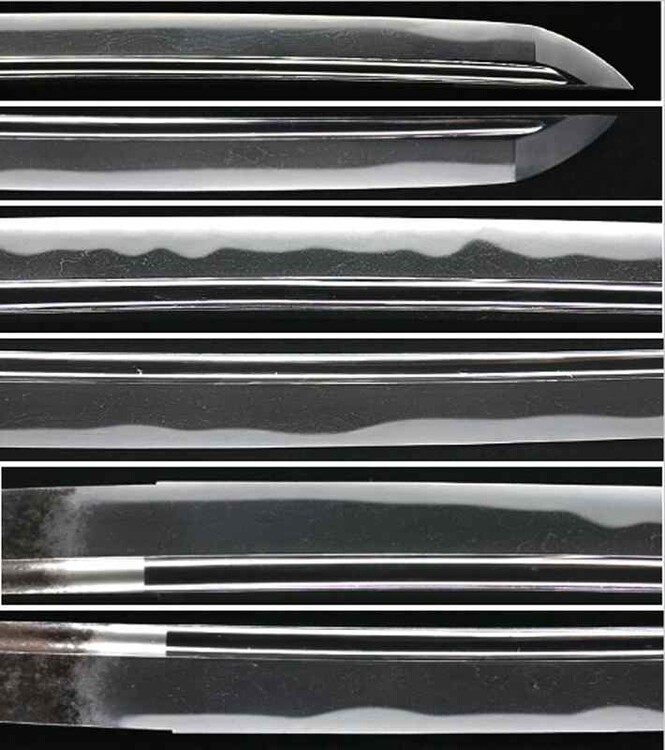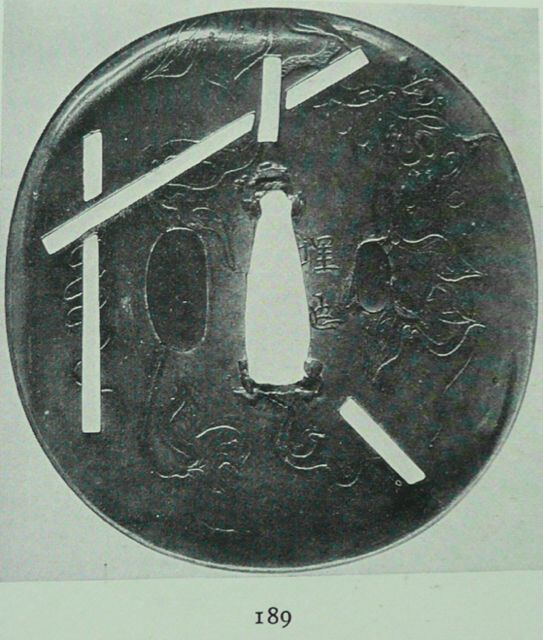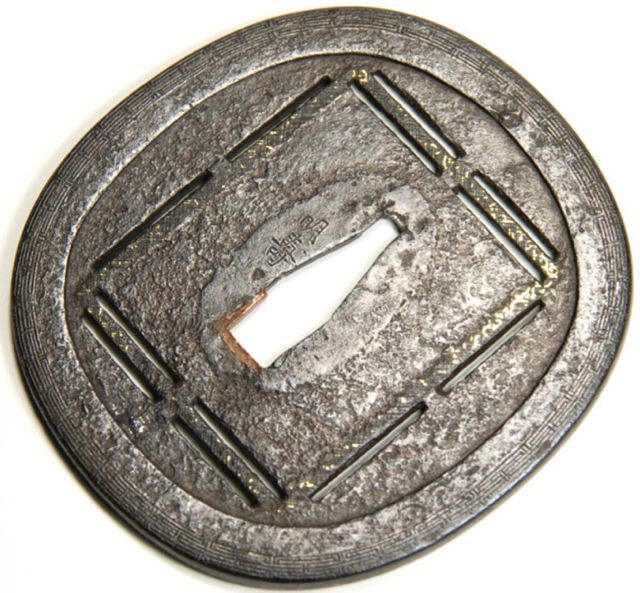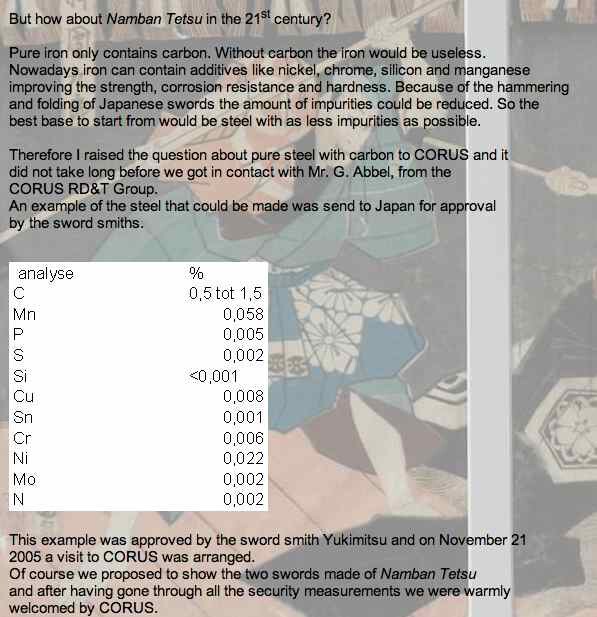-
Posts
1,029 -
Joined
-
Last visited
Content Type
Profiles
Forums
Events
Store
Downloads
Gallery
Everything posted by Eric H
-
As expected no guesses ....this Tanto with a hoso suguha hamon in nie-deki is signed BIZEN OSAFUNE KAGEMITSU KARYAKU NI-NEN JU-GATSU HI (1327) Bizen Kagemitsu is famous for his kataochi gunome hamon in nioi-deki. According to Nobuo Nakahara, the quality of a sword is primarily judged on the quality of its nioi-guchi and he states Kagemitsu‘s nioi-guchi to be exemplary and perfect. The Tanto on the zufu is signed BISHU OSAFUNE JU KAGEMITSU SHOCHU NI-NEN JUICHI-GATSU HI (1325) Nagasa: 26 cm Sori: slight uchizori Motohaba: 2.25 cm Mitsu-mune Jitetsu: tight itame hada with ji-nie and chikei Hamon: kataochi gunome, with ashi and kinsuji in the ha, the nioi-guchi is bright Bo-utsuri Horimono: Kurikararyu and on the ura Gomabashi Eric
-
I have read there are collectors in Japan who put to the test to supposed „experts“ by presenting for kantei a sword in „kawari deki“, i.e. not representing the smiths typical blade characteristics. As an example Tanto: 22,2 cm Sori: muzori Motohaba: 2.1 cm Kasane: 0.41 cm Jitetsu: small itame hada well grained with much jinie and chikei appears Hamon: small niedeki suguha brightly hamon and in the ha many small ashi works Kenmakiryu is engraved and on the reverse side a bohi Any ideas on the maker of this Tanto? Eric
-

Definition of the term, Keiba Dachi
Eric H replied to sanjuro's topic in General Nihonto Related Discussion
-
The 3 wakizashi‘s, some of them are rusted and chipped, and the nakago‘s are undetected, i.e. you do not know if they are signed or possibly shortend. Under these conditions keep away. You are living in a European country as you talk about Euro. Well € 1500 are ca. $ 2000. It is better to wait and to buy something in a price range a bit higher, but a sword signed and papered, that will give you full satisfaction and is in any case salable. Have a look at this site, Wakizashi Ujifusa f.e. http://www.nihonto.com/8.6.10.html There are other reliable dealers in USA Eric
-
These are pictures of a Soshu Yukimitsu Tokubetsu Juyo Token and I advise to enlarge them if possible. Eric
-
Indeed the source of my contribution is that blogspot. There is no author named, but the following sentence points most likely to Kenji Mishina as author. Actually I am a sword polisher belong to the Hon-ami school as my teacher Nagayama Kokan learnt sword polishing from Hon-ami Koson who succeeded as head of one of the Hon-ami families. BTW I'm surprised to hear that unknown people from the Baur Museum allegedly know more than the author of this article...what a nonsense Eric
-
History of Sword Polishing...excerpt from an article A description of sword polishing is seen in a document called 'Engi-shiki' was written in 905 for the first time. Meanwhile, the oldest recognisable polishing on a Tanto (or dagger) was discovered from inside the body of a Buddha image made in 1274. The Tanto was polished with one of the finishing stones called Uchigumori and Migaki or a kind of burnishing was done on a part of the blade. In this case, Tsuya (or finger polishing with thin and tiny pieces of finishing stone called 'Narutaki') and Nugui ( or polishing powder) seem not to have been employed. But it is speculated that there was already a similar method to modern finishing work in that period. (Completion of sword polishing) It seems that the traditional sword polishing we can see today was completed by the mid 10th Century. In a history book called 'Kanchi-in Bon' which describes the history of the early 14th Century, sword polishers' name were seen for the first time. In the book there are two polishers' name called 'Kunihiro' and 'Tamesada' who were chosen by the ex-Emperor Gotoba in order to polish the swords made by Goban-kaji who were designated the monthly smiths who worked for the ex-Emperor. Incidentally the ex-Emperor Gotoba had a profound knowledge of the Japanese sword and was an expert of sword appreciation. The description proves that the sword polishing which makes the sword appreciation, possible had been completed by then. Since then the word 'Polishing' began to be used for sword polishing, thus it definitely had a different meaning from grinding or sharpening of edged tools. It is now thought that three stages of sword polishing already existed in the early Heian period of the mid 9th Century. (Sword polishing and artistic value of the Japanese sword) From the previous description we can speculate that they already had a recognition that the Japanese is not only an excellent weapon but also one of fine arts in the early 13th Century. When we talk about the practical aspect of a sword, finishing work with extremely fine stone is not necessarily needed and the stage of a middle grain stone called Nagura would be ideal to make the sword work practically. Furthermore, polishing stages after the Nagura stone were developed in order to enhance the artistic value and expose mysterious beauty of the Japanese sword. The unique finishing work using Uchigumori and Narutaki stones is the only way to bring out the patterns of the Jihada and the Hamon properly. In fact, we have no other option. In a sense, it might be said that the artistic value of the Japanese sword was established and has been appreciated highly because of this exceptional sword polishing. Eric
-

Help Photographing Fittings....
Eric H replied to Lindus's topic in General Nihonto Related Discussion
Requirements for Tosogu Photographs to be submitted to the Kokusai Tosogu Kai and a Method of Photography to meet these Requirements Version 2.0 By Richard K. George http://www.rkgphotos.com/articles/ktk_p ... t_2007.pdf Eric -
Professional polishers are in direct contact with rusted blades they have to restore. I believe they know very well how to prevent and stop further rusting of a blade, don‘t they? We are lucky to have some of them on the NMB, and perhaps they will give, based on their experiences, the right advices... at any rate I hope so Eric
-
Hereby 3 examples of Soshu Yukihiro‘s hada: The steel is very fine and beautiful with an abundance of ji-nie and chikei. The grain is ko-itame mixed with mokume, which in places becomes o-hada. and additionally part of a sayagaki by Honami Koson considered not reliable. Eric
-

Is this a real deal wakizashi?
Eric H replied to shingen's topic in Auctions and Online Sales or Sellers
Asking for an advice is OK. Well, regarding this wakizashi, which in fact is a wreck, the blade as well as the koshirae. It is a well known rule which says „not to spoil the eyes by looking at low quality swords“... instead to study the best...(from this wakizashi nothing can be seen)...that is however very difficult except for those who can look at them at first hand presentations at sword clubs or at kantei. Secondly, the opinion to learn on the quality of swords by learning their „defects“ is a completely wrong approach...the other and right way inter alia is to learn about the beauties of a sword...that requires a sword in full professional polish. The web on the other hand offers the opportunity to see pictures of first quality swords. Eric -
-
KEEP AWAY FROM EBAY ! Buy a sword with: professional polish...absolute prerequisite for viewing. Origami...smith, school etc. are defined, you know exactly what you have and there is no nessesity to submit it later to shinsa. Buy in confidence from a US dealer, there are many reputable on the web...no need to buy from Japan now, the changing rate is unfavorable. Eric
-
Myoju‘s legacy is extremely poor regarding the existing swords he has left...a Tachi 64.7 cm now in the Kyoto National Museum, a shinogi-zukuri Wakizashi, a Ken, and some Tantos. Most of his Tantos are katakiriba-zukuri, his Horimono are of the highest quality. Umetada Myoju is known as one of “the best three artist in the Momoyama era” along with Kaneie, and Nobuie in the toshingu world. His family was working for the Ashikaga shoguns, and they did a lot of work to shorten and make swords suriage which was common at that time, along with making zogan mei, and toso kanagu. Myoju was a sword smith, and he was known as a founder of the Shinto school and he was a very good toshin-bori smith ( carving or making horimono on swords). Myoju has two types of tsuba, and one type is made of iron with raimon, and sayamon (geometric regular) patterns with some gold nunome zogan, which is a classic elegant Ko- Shoami style used since the Muromachi era. The other style uses brass or red copper for a base, and uses gold, silver and copper for hirazogan, with patterns of trees or vines such as grape, kunenbo hakugi, and shochiku mon (graphic patterns). These are very elegant and gorgeous typical Momoyama period patterns. (NBTHK Journal) Eric
-

1st NBSK SWORD CRAFTSMEN COMPETITION RESULTS
Eric H replied to Bazza's topic in General Nihonto Related Discussion
Hearty congratulations to the prize winners FORD HALLAM (South Africa) Tsuba brass base with the design of a dragonfly and BRIAN TSCHERNEGA (USA) Solid gold double habaki Eric -
Well, this sentence exactly and most of the article is written in Guido Schiller's SASHIKOMI VS. HADÔRI, AND POLISHING IN GENERAL - A PERSONAL VIEW* C.U. Guido Schiller SFI Staff / Nihontô Editor July 16, 2004 I think the author should have been mentioned by fairness in the "Reference's" Eric
-
-
Jean, Even the sharpest eyes cannnot see more than a shinogi-ji and hiraji completely uniform in appereance, pitted and stained, no hamon is discernible. What to do is to open a „window“, if a proper restoration is desired...but that would have to think twice...just my opinion. Eric
-
The hada is obscured, no details are visible and I wonder that under these conditions an attribution to a defined school should be possible. Left - hada of a Uda Kunimune Tachi, Oei days. Right- hada of a Katana attributed to Uda, late Muromachi period. Eric
-
Some of the previous seriously and well meant recommandations have been devalued...here is a site for the newbies where THEY can evaluate what is suitable for them. This books are available and there is „no smell of something like sentimentality in the air“ http://www.satcho.com/Tosogu.htm Eric
-
Informative video and especially interesting for those who recognise that aside swords many wonderful arts and crafts also can be appreciated. Thank you for sharing :D Eric
-
Coming back to the NAMBAN TETSU PROJECT the „new“ Namban-tetsu had to be evaluated for the test...I don‘t know how close this „new“ Namban-tetsu comes to the „old“ Namban-tetsu, however the test was performed with two small blocks. „Namban-tetsu was a highly sought after and expensive commodity...“ I have read in the previous article...and I believe those swordsmiths knew very well to judge the „qualities“ of the foreign steel. Eric
-
Roger, many thanks for this enlightening article Eric
-
Robinson has never described one of those blades displayed on the photos...therefore never a comment on authenticity... only sword type, if signed or attributed, from which collection eventually, and the indication of the smith's working period. As I have pointed out earlier most of his book is an abstract from Honami Koson‘s work, who was a recognised expert and connoisseur at that time. Robinson‘s book BTW is nowadays rarely available. Eric
-
That's a fact, some of those swords turned out to be gimei. Thank you Paul for your comment that gives justice on the merits of a veritable gentleman's life's work Eric





















